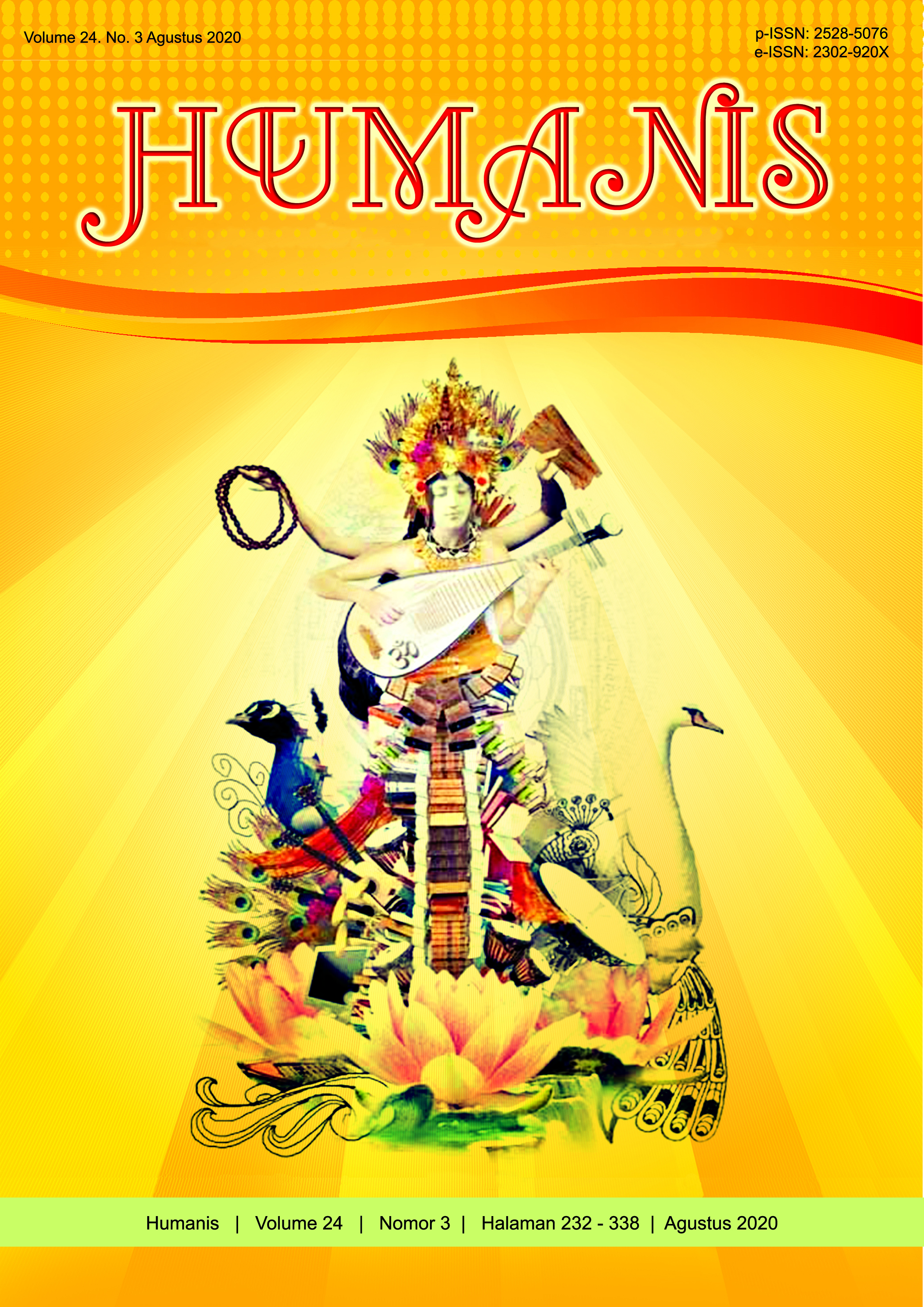Eksistensi Sanggah Kemulan Nganten dalam Upacara Perkawinan Masyarakat Desa Pedawa
Abstract
The community in Pedawa village, sub-district Banjar, districts Buleleng knows the term marriage they call with 'melaib' which is a local term which means to marry. Every man in Pedawa village who is married is obliged to make Sanggah Kemulan Nganten which is manifested in a series of wedding ceremonies. Sanggah Kemulan Nganten or also called sanggah tiing (a place of worship it made from bamboo) is a pelinggih (place of worship) symbol of the part of a new household from the individual. This study refers to understand and identify the process of the realization of Sanggah Kemulan Nganten in the marriage ceremony in the Pedawa village and, to find out and identify the meaning of Sanggah Kemulan Nganten in the life of the Pedawa village. The results of the study show that Sanggah Kemulan Nganten must be made by men. This refers to harmonize the household and block from the disease. Mandatory ceremony to establish Sanggah Kemulan Nganten is ngamputang lis. The meaning of religion from Sanggah Kemulan Nganten is to establish the belief in the existence of supernatural powers from Sanggah Kemulan Nganten. The meaning of solidarity from Sanggah Kemulan Nganten is participation and community support in the activities of establishing Sanggah Kemulan Nganten. The cultural meaning of Sanggah Kemulan Nganten is namely the pedawa village community,believes in local traditions or culture, which is in accordance with the mandate that has been passed down by generations of pedawa village ancestors.
Downloads
References
Heriyawati, Yanti. 2016. Seni Pertunjukan Dan Ritual. Yogyakarta: ombak.
Nika, Maritfa, dan Mohammad Mukti. 2013. Jurnal Kajian Eksistensi Pasar Tradisional Kota Surakarta. Solo: ejurnal Undip Volume 2 No. 2.
Pramana, Dewa. 2017. Tradisi Naur Kelaci dalam Upacara Perkawinan di Desa Subaya, Kecamatan Kintamani, Kabupaten Bangli. Program S1 Antropologi. Universitas Udayana Volume 23 No.1.
Riski dkk. 2014. “Simbol Dan Makna Pernikahan Ritual Pernikahan Adat Jawa Di Desa Sukomanah Kecamatan Purwodadi Kabupaten Purworejo”. Yogyakarta. Jurnal Universitas Negeri Yogyakarta Volume 3 No. 7.
Spradley, J.P. 1979. The Ethnographic Interview. New York: Reinhart & Winston.
Spradley, J.P. 1980. The Participation Observation. New York: Reinhart & Winston.
Windia, Wayan, P. dkk. 2009. Perkawinan Pada Gelahang di Bali. Denpasar: Udayana Press.
Dade, Yacobus Tenabolo. 2012. Dinamika Belis dalam Adat Perkawinan Masyarakat Rote Ba`a di Kelurahan Mokdale Kecamatan Lobalain Kabupaten Rote Ndao. Program S1 Antropologi. Jurnal Universitas Udayana Volume 1 No.1.
Kusmirayani, Luh Ayu. 2013. Perkawinan Padagelahang di Bali Perspektif Antropologi. Program S1 Antropologi. Jurnal Universitas Udayana Volume 3 No.1.
Laksmi, Ni Luh Gede Eni. 2014. Tutur Ardhasmara Analisis Struktur dan Semiotika. Program S1 Sastra Jawa Kuno. Jurnal Universitas Udayana Volume 7 No.1.
Dharmapatni, Desak Putu Diah. 2016. Adaptasi Wanita Islam Terhadap Keluarga Suami Studi Kasus Perkawinan Amalgamasi Wanita Islam dan Pria Hindu di Bali. E-Jurnal Humanis Unud Volume 15 No.1.
Hartawan Dana Putra dkk. 2017. Makna Ritual Nyepeg Sampi dalam Upacara Usaba Kawulu di Desa Adat Asak Kabupaten Karangasem. Jurnal Humanis, Fakultas Ilmu Budaya Unud Volume 21 No.1.
Fauziana Rahmat dkk. 2017. Representasi Simbol Titi Gonggang di Pura Agung Gunung Raung Desa Taro, Kecamatan Tegallalang, Gianyar. Jurnal Humanis, Fakultas Ilmu Budaya Unud Volume 21 No. 1.
Manalu, Mely Tri Santy Br. 2013. Kebertahanan Perkawinan Ideal Menurut Suku Batak Karo di Kelurahan Kwala Bekala Padang Bulan Medan (Suatu Tinjauan Antropologi). Jurnal Humanis Unud Volume 2 No. 1.
Sipayung, Frans Kurnia. 2015. Dinamika Sistem Upacara Perkawinan Batak Simalungun di Kabupaten Simalungun, Sumatra Utara Tahun 1950-2010. Jurnal Humanis Unud Volume 11 No. 1.


















